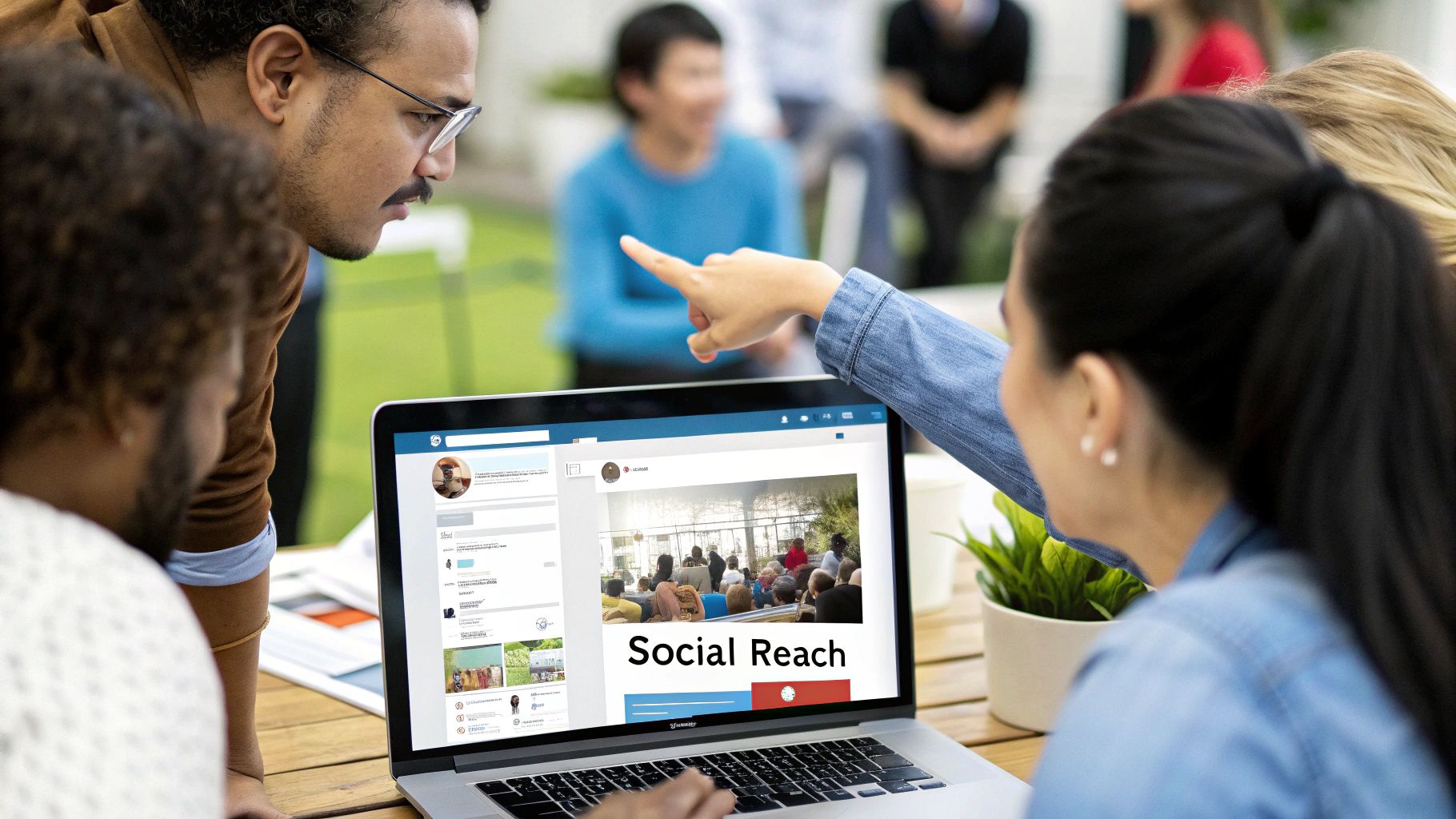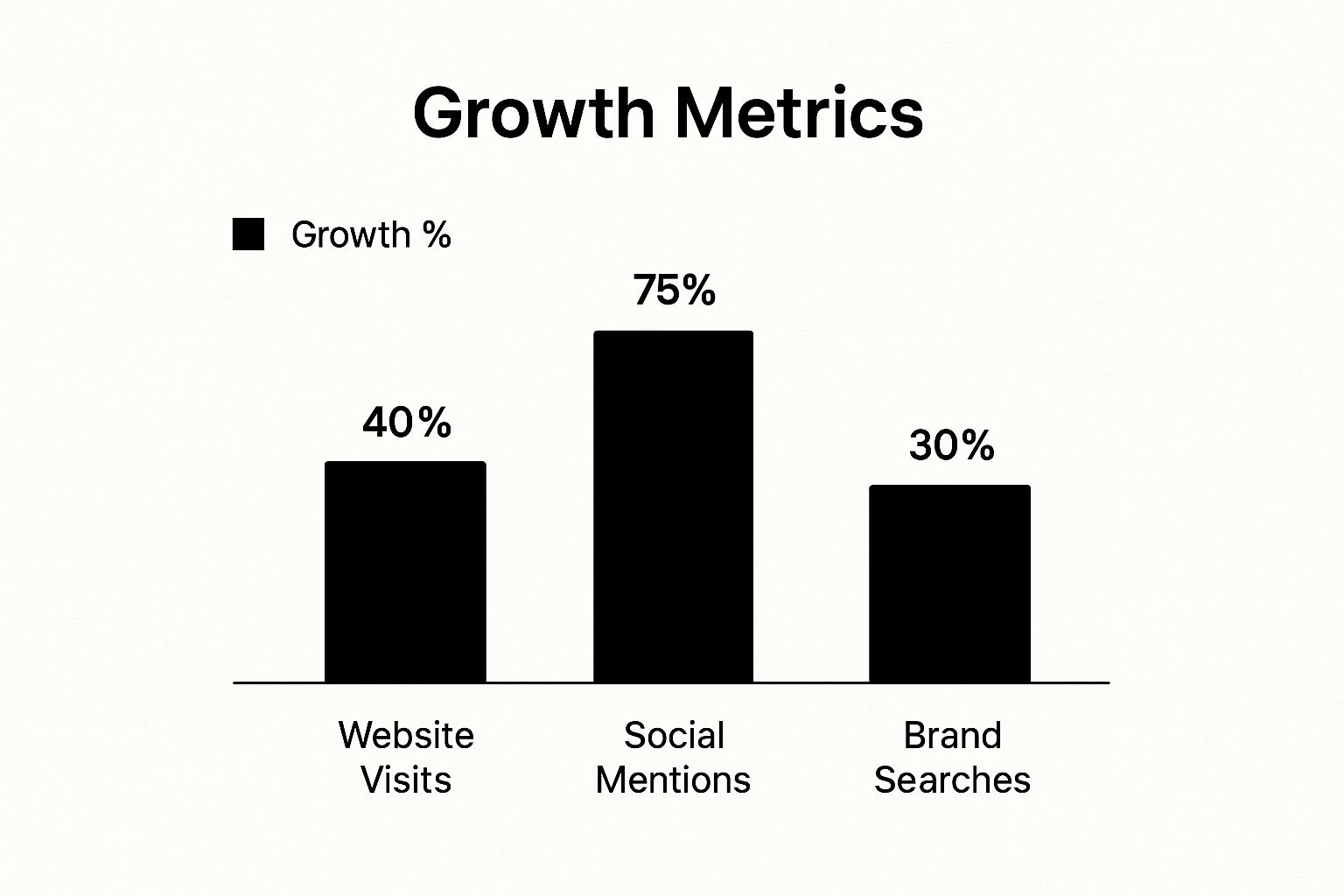
How to Improve Brand Awareness with Proven Strategies
Discover how to improve brand awareness using social media, content, and influencer strategies. Learn actionable tactics to grow your brand's reach.
Building up brand awareness is all about becoming memorable. It’s about creating a consistent, recognizable presence wherever your potential customers are hanging out online.
Building Your Brand Awareness Foundation

Before you even think about launching a campaign, you need to get your foundation right. I like to think of a brand as a person—it needs a distinct personality, a clear voice, and a consistent look. A logo is just the start. Every single thing you put out there, from a quick TikTok video to an email subject line, has to feel like it came from the same source.
This is what builds real trust and recognition over time.
This foundation really comes down to three things: a defined brand identity, a deep understanding of who you're talking to, and being relentlessly consistent. If you skimp on these, your marketing efforts will feel scattered and just won't stick.
Before we dive into tactics, let’s quickly recap the foundational pillars. Think of this as your pre-launch checklist for any brand awareness push.
Core Brand Awareness Pillars
| Pillar | Key Action | Why It Matters | | --- | --- | --- | | Brand Identity | Define your mission, values, and personality. | This shapes your brand voice and creates an emotional connection with your audience. | | Target Audience | Create detailed customer personas. | You need to know exactly who you're talking to, where they are, and what they need. | | Consistency | Apply your brand voice and visuals across all channels. | This builds recognition and trust, making your brand memorable over time. |
Nailing these elements ensures that every piece of content you create works together to build a strong, cohesive brand that people remember.
Defining Your Brand Identity and Voice
Your brand identity goes way beyond just your logo and color scheme. It's the gut feeling people have about you. A great place to start is by hammering out your mission and core values. What do you really stand for? This will be the compass for your brand voice—the specific tone and language you use everywhere.
Are you playful and a bit cheeky like Wendy's on social media? Or are you more buttoned-up and professional like IBM? Figuring this out is critical to making sure your message actually connects with the right crowd. For a deeper look at different approaches, you can explore various strategies to increase brand awareness.
A strong brand voice makes your business feel human, which makes it far more relatable and memorable. It’s what separates a forgettable corporate drone from a brand that feels like a friend you can trust.
Pinpointing Your Target Audience
Here’s a hard truth: you can't be everything to everyone. Trying to is a recipe for failure. To make any real headway with brand awareness, you have to know exactly who you're trying to reach. Ditch the broad demographics and start building out detailed customer personas.
- Who are they, really? Go beyond age and location. What’s their job? What are their hobbies and passions?
- Where do they live online? Are they endlessly scrolling Instagram, building connections on LinkedIn, or asking for advice on Reddit?
- What keeps them up at night? Understand their biggest pain points—the problems you can actually solve for them.
When you have these answers, you can create content that speaks directly to their world and show up in the places they already spend their time. It’s the difference between shouting into the void and having a meaningful conversation. Your message doesn't just get seen—it gets felt.
And this isn't just fluff; the data backs it up. It typically takes 5 to 7 impressions for someone to even begin to remember a brand. Keeping that presentation consistent can seriously boost revenue. In fact, just picking a signature color can improve brand recognition by up to 80%, which shows you just how powerful a unified look and feel really is.
Using Social Media for Maximum Brand Visibility

Think of social media platforms less like digital billboards and more like dynamic ecosystems. This is where your brand can build a real personality, talk directly with customers, and earn their loyalty.
To actually boost brand awareness, you have to treat each platform like its own unique community—complete with its own rules, language, and expectations. A one-size-fits-all strategy just doesn't work here.
The secret is to be strategic. Instead of trying to be everywhere at once, focus on the platforms where your target audience actually hangs out. A B2B tech company, for instance, will get much more traction on LinkedIn, while a fashion brand will feel right at home on visually-driven platforms like Instagram and TikTok.
Choosing Your Core Platforms
Picking the right channels is your first real move. Don't just jump on a trend; go where your customers already are. This single choice will shape your entire content strategy, from the format of your posts to the tone of your captions.
Here’s a quick rundown to help you decide:
- Instagram & TikTok: Perfect for visual-heavy brands in fashion, food, travel, and beauty. Short-form video (Reels, TikToks), eye-catching images, and influencer marketing are king here.
- LinkedIn: The undisputed champion for B2B companies, industry experts, and professional networking. It's the ideal spot for sharing deep insights, company updates, and detailed articles.
- Facebook: With its massive user base, it’s still a powerhouse for building communities through Groups and connecting with a wide range of demographics.
- X (formerly Twitter): Your best bet for real-time news, jumping into trending conversations, and providing snappy customer service.
Once you’ve locked in your platforms, it's time to build a content calendar that provides value first and promotes second. A great rule to follow is the 80/20 principle: 80% of your content should educate, entertain, or engage, while only 20% is a direct sales pitch.
Mastering Community Management
Real brand awareness isn't about how many people you reach; it's about the relationships you build. This is where active community management becomes your secret weapon.
Responding to comments, answering DMs, and celebrating user-generated content are the actions that turn passive followers into die-hard fans.
And it's a strategy that's proven to deliver. Recent data shows a whopping 89% of companies reported better visibility from active social media branding. Small businesses lean on it heavily, with 76% using social channels to get their name out there. Even better, 77% of consumers say they prefer buying from brands they follow on social media. You can dig into the full branding statistics on Cropink.
Your social media should feel like a two-way conversation, not a monologue. When customers feel seen and heard, they are far more likely to remember and recommend your brand.
To keep things moving in the right direction, you need to track what's working. Keep a close eye on your engagement rates, reach, and follower growth. This data is pure gold, telling you exactly what content resonates with your audience so you can fine-tune your approach. If you're new to this, we have a detailed guide to help you master your social media analytics dashboard. It’s all about making smart, data-driven decisions that genuinely move the needle on brand awareness.
Scaling Your Efforts with AI and Automation

Trying to manually create content and post across every channel is a one-way ticket to burnout. If you really want to scale your brand awareness, you have to work smarter, not just harder. This is where AI and automation tools become your secret weapon, letting a small team punch way above its weight class.
Instead of sinking hours into designing one graphic or editing a 15-second video, you can now use AI to generate stunning visuals, draft compelling copy, and even stitch together short-form video clips in minutes. This frees up your most valuable resource—your creative brainpower—for high-level strategy and actually engaging with your community.
Automating Your Content Pipeline
Consistency is everything on social media, and automation is the engine that makes it happen. Tools like Buffer or Hootsuite are perfect for this. They let you build out your entire content calendar weeks or even months ahead of time, then automatically publish your posts at the best times for each platform.
This isn't just about saving time; it's about being strategically present. A well-oiled schedule means you never miss a chance to connect with your audience. For a deeper dive into setting these systems up, exploring the top marketing automation best practices can give you a solid roadmap to follow.
Automation handles the repetitive tasks so you can focus on the human ones. It’s about building a system that keeps your brand visible, even when you’re busy running the rest of your business.
A Practical Tech Stack in Action
Let's make this real. Imagine you run a small e-commerce brand. Your goal is to post three times a day on Instagram and TikTok to get your name out there. Manually, that’s a full-time job. With a smart tech stack? It's completely manageable.
Here’s a simple workflow:
- Content Creation: Fire up an AI image generator and create a week's worth of visual content in under an hour. Then, use an AI writing assistant to draft engaging captions for each one.
- Scheduling: Upload all that content into your scheduling tool. You can set the exact dates and times for each post to go live, targeting when you know your audience is scrolling.
- Execution: Now you can relax. The scheduler takes it from here, pushing your posts out automatically. Your feed stays fresh, and your brand stays top-of-mind.
This kind of workflow turns your content strategy from a daily grind into a streamlined, strategic operation. It allows you to compete with much bigger brands by being consistently present and relevant, all without the massive overhead.
Build Real Trust With Influencer Partnerships
Creating your own content is table stakes, but tapping into existing, thriving communities? That’s how you fast-track brand awareness. Influencer marketing gives you a direct line to audiences that already trust a creator's word, making it an incredibly potent tool.
But here’s the secret: it’s not about chasing massive follower counts. The real wins come from partnering with creators whose audience and values genuinely mirror your own. A micro-influencer with 10,000 die-hard fans in your niche will almost always deliver more value than a mega-influencer with a million passive scrollers.
When the fit is right, the endorsement feels like a natural recommendation from a friend, not a clunky, forced advertisement. You're looking for partners who would actually use and get excited about your product, which turns their content into a powerful signal for their community.
Finding and Vetting the Right Creators
The hunt for the perfect influencer is more about deep-dive research than a quick hashtag search. Start by looking for creators who are already part of the conversation in your industry. Pay less attention to likes and more to the quality of the discussion happening in their comments.
- Look at the Engagement Quality: Are the comments just "nice pic!" or are people asking thoughtful questions and having real back-and-forths? That’s the sign of a loyal, trusting audience.
- Check for Brand Vibe: Go through their past content. Does their tone, aesthetic, and overall message feel like a natural extension of your brand? A mismatch here will stick out like a sore thumb.
- Review Their Past Partnerships: How have they worked with other brands? You want creators who weave products into their content seamlessly, not those who just post generic, copy-paste ads.
Once you have a shortlist, your outreach needs to be personal. A generic, templated DM is a one-way ticket to being ignored. Mention a specific post of theirs you genuinely liked and explain why you think a partnership would be a home run for their audience.
An influencer partnership is a collaboration, not a transaction. The best results happen when both you and the creator are genuinely pumped to work together and bring something cool to their audience.
How to Structure a Winning Collaboration
A great partnership runs on clear communication and a deal that benefits everyone. Kick things off with a detailed partnership brief that lays out everything you need. Think of it as your campaign’s north star.
Your brief should nail down the specifics:
- Campaign Goals: What's the end game? More website clicks, a ton of social mentions, or something else entirely?
- Key Talking Points: Give them the must-knows about your product but leave room for their personality and creativity to shine.
- Content Deliverables: Be specific. Are you looking for one Reel and three Stories? Spell it out.
- Timeline: Set clear, realistic deadlines for when you need to see drafts and when the content should go live.
Getting this all down on paper prevents headaches and ensures the final content is on-brand while still feeling authentic to the creator. To really make an impression and get things started on the right foot, it helps to understand strategies like sending thoughtful gifts. Learning what a PR package is and how to use it can give you a tangible way to build a strong relationship from that very first interaction.
Harnessing User-Generated Content for Social Proof
Let's be real: your happiest customers are your best marketers. Their authentic posts, stories, and reviews are pure gold. This is the power of User-Generated Content (UGC)—it’s social proof that cuts through the noise and builds trust in a way that slick, branded ads just can't.
But you can't just sit back and hope your customers start posting. You need to give them a little nudge. Simple contests, a fun branded hashtag, or just a clear call-to-action can be all it takes to get people sharing their experiences. The key is making it feel like a community activity, not a marketing ploy.
Sparking Creativity with UGC Campaigns
Kicking off a UGC campaign doesn’t need to be some huge, complicated production. Start small with a simple, engaging idea.
Imagine you're a coffee brand. You could launch a contest with the hashtag #MyMorningMugshot, asking followers to post their most creative coffee snaps. The prize? It could be a free bag of beans or a feature on your page.
This creates a fantastic feedback loop:
- You get real content: Photos from actual customers show your product in its natural habitat.
- Customers feel included: They’re now part of your brand's story, not just a name on an order receipt.
- Your reach explodes: Every post is a mini-endorsement broadcast to that person's entire network.
Just remember one crucial rule: always ask for permission before you repost. A quick, friendly DM is all it takes to show respect and keep things above board. If you're looking for a complete walkthrough, we've put together a guide on how to create a killer UGC campaign from start to finish.
Think about it—when a friend recommends a product, you listen. UGC works the same way. It's a digital word-of-mouth recommendation that makes your brand feel instantly more human and trustworthy.
To get your creative juices flowing, here are a few ideas for different platforms.
UGC Campaign Ideas by Platform
| Platform | Campaign Idea | Goal | | :--- | :--- | :--- | | Instagram | Photo contest with a branded hashtag (#YourBrandStyle). | Collect high-quality visual content for your feed and ads. | | TikTok | Create a branded sound or a challenge (e.g., unboxing video). | Drive viral engagement and tap into trending content formats. | | X (Twitter) | Ask a "fill-in-the-blank" or "caption this" question. | Spark quick, shareable text-based testimonials and engagement. | | Facebook | Ask customers to share stories or memories in a dedicated group. | Build a strong community and gather in-depth, emotional testimonials. |
These are just starting points, of course. The best campaigns feel authentic to both the platform and your brand's unique voice.
Repurposing Customer Content Strategically
Once you’ve started collecting all this great UGC, don't just let it die on one social feed. Put that content to work everywhere.
Sprinkle customer photos across your product pages. Weave video testimonials into your email campaigns. Turn the best-performing UGC into high-converting paid ads. This not only solves your content calendar woes but constantly reinforces the idea that you have a thriving community of happy customers.
The impact isn't just anecdotal, either. The data shows just how powerful this can be.

When you let your customers do the talking, you build a powerful, self-sustaining engine for brand awareness. It’s authentic, effective, and it turns your audience into your most passionate advocates.
Alright, you've launched the campaigns and the content is flowing. But how do you actually know if it's working? If you're not measuring your progress, you're flying blind.
Proving that your brand-building efforts are paying off is everything, but it means looking past the easy vanity metrics like likes and follower counts. Those are nice, but they don't tell the whole story.
Real growth comes from signals that show your brand is genuinely capturing attention and carving out a bigger space in your industry. It's time to shift your focus to data that proves people are actually paying attention.
Key Metrics That Actually Matter
To get a true read on your brand's footprint, you need to track metrics that show genuine audience interest and recall. These numbers tell a much richer, more meaningful story than a simple engagement rate.
Start keeping an eye on these key areas:
- Direct Website Traffic: This is a big one. When people type your URL directly into their browser, it’s a powerful sign that your brand is memorable. It’s a pure indicator of brand recall, completely separate from search or social media clicks.
- Branded Search Volume: Are more people searching for your brand name or specific products on Google? That's another crystal-clear signal. It shows your marketing is successfully sparking curiosity and driving people to actively seek you out.
- Social Mentions: This goes way beyond your own posts. Are people talking about you? Use social listening tools to track untagged mentions. This gives you an unfiltered, honest look at the conversation happening around your brand.
Tracking these metrics over time gives you the hard evidence that your strategies are connecting. It’s the data that shows you're not just making noise; you're building a name that people remember.
Tools and Techniques for Tracking
The good news? You don't need a massive budget to monitor your brand's presence. There are simple, effective tools out there that can give you a ton of information.
Setting up Google Alerts for your brand name is a fantastic, free place to start. You'll get notified anytime your brand pops up on a website or in the news. For a more complete picture, social listening software can track conversations across different platforms, helping you understand the sentiment behind the mentions.
The goal isn't just to collect data, but to figure out what it means. Are the mentions positive? Are they happening in new online communities? This is the kind of insight that helps you refine your strategy and double down on what’s actually working.
This data demonstrates the real, tangible return you're getting from your brand-building efforts. The financial impact can be massive; the top 100 global brands recently hit a collective value of $10.7 trillion. Just look at Apple, valued at $1.3 trillion, which shows how sustained investment in brand drives both awareness and fierce loyalty. You can review the full Kantar BrandZ Global report to see the deep connection between brand value and awareness.
For a more advanced way to understand how all your marketing channels work together, you might want to explore marketing mix modeling. This method helps you attribute growth to specific campaigns, proving the direct value of every single marketing dollar you spend.
Ready to create, automate, and schedule viral content that builds unstoppable brand awareness? ViewPrinter provides all the AI-powered tools you need in one platform. Start building your brand’s reach today.